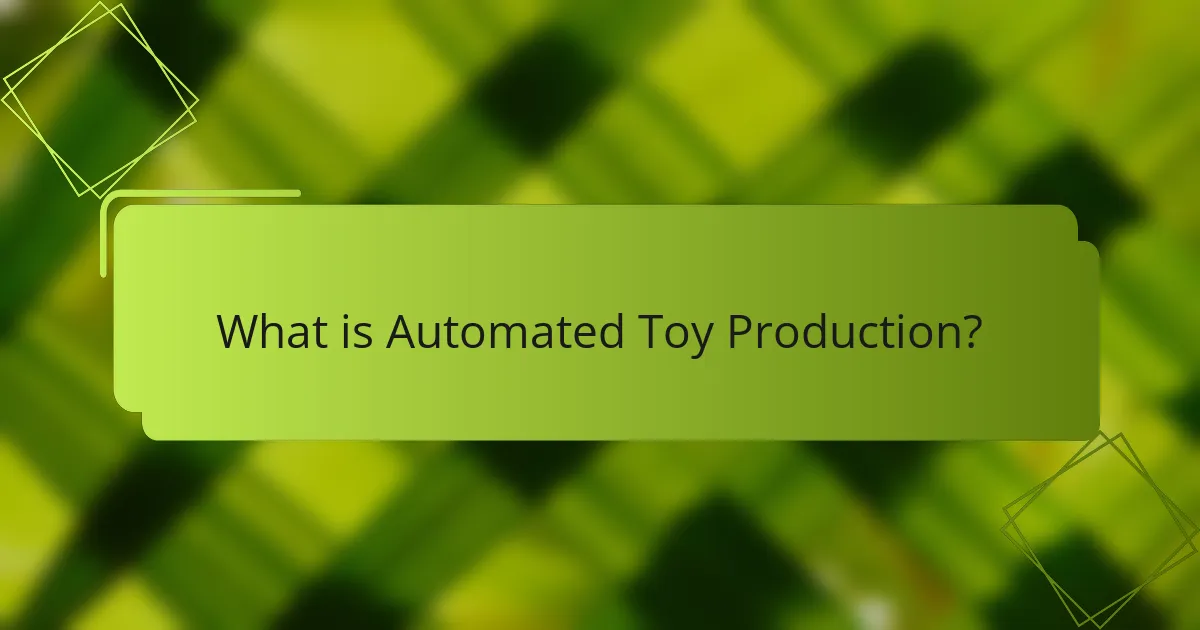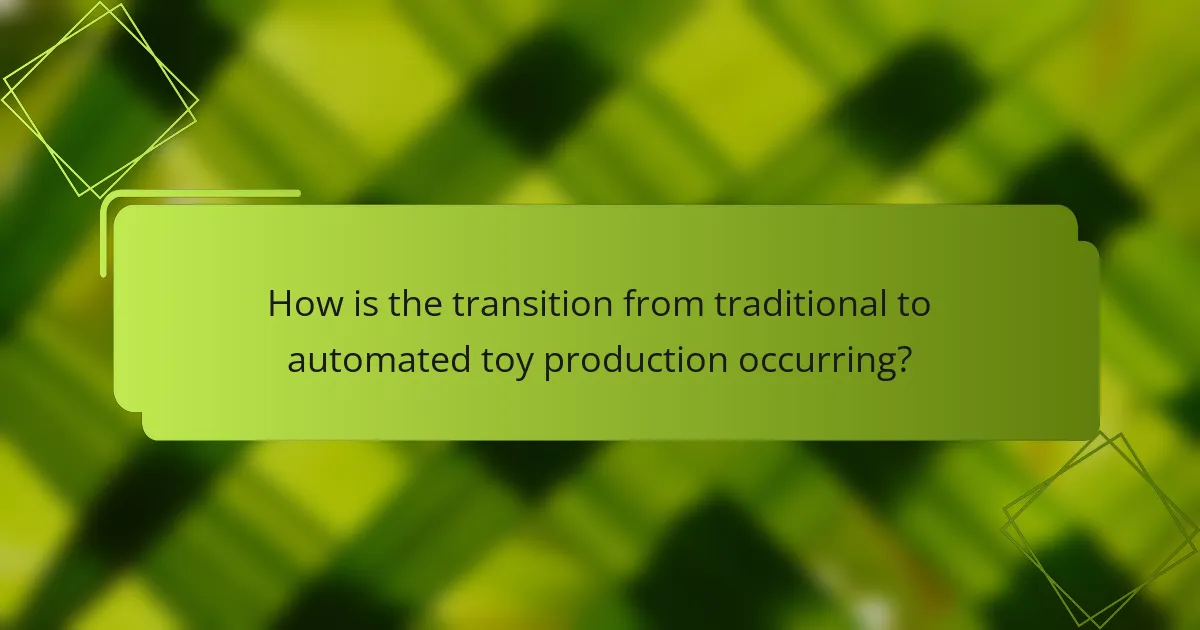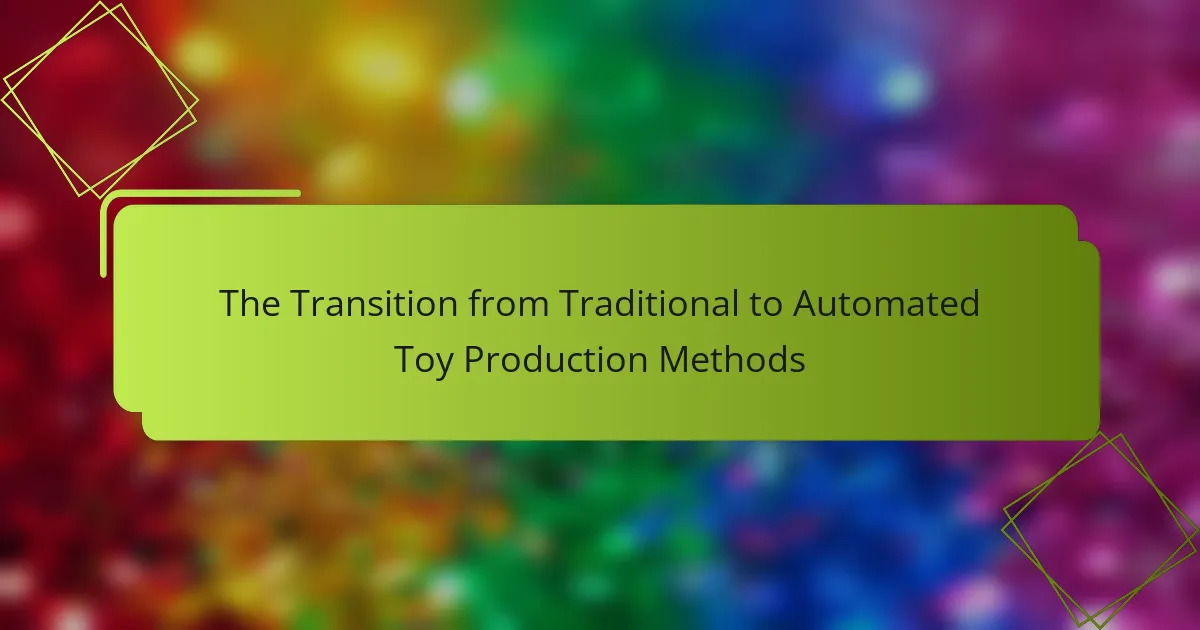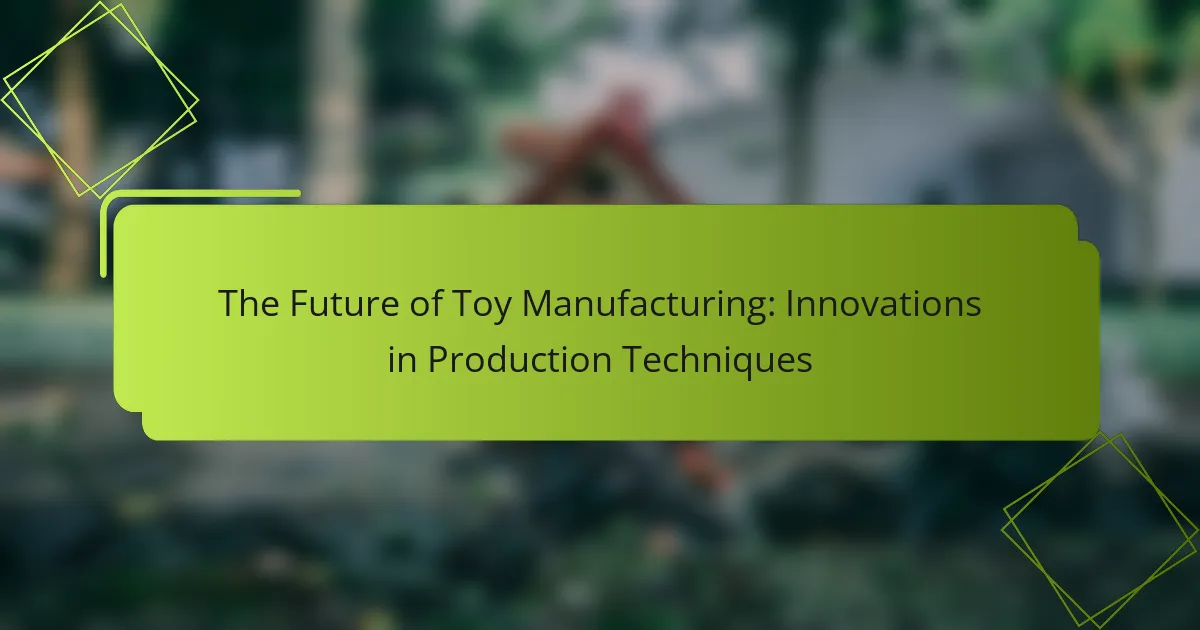
What are Traditional Toy Production Methods?
Traditional toy production methods involve handcrafted techniques using basic tools and materials. Artisans typically carve, mold, or assemble toys manually. Common materials include wood, cloth, and metal. These methods emphasize craftsmanship and unique designs. Historically, traditional production was prevalent before industrialization. Factories began to replace these methods in the late 19th century. Traditional toys often reflect cultural heritage and local craftsmanship. Many modern toy makers are now reviving these methods for sustainability and uniqueness.
How do traditional methods differ from modern approaches?
Traditional methods of toy production rely on manual craftsmanship and artisanal techniques. These methods often involve hand assembly, limited production runs, and individual customization. In contrast, modern approaches utilize automation and advanced technology. Automated production lines can manufacture toys at a much larger scale and with greater efficiency.
For example, modern methods often incorporate robotics and computer-aided design (CAD). This allows for precision and consistency in production that traditional methods cannot match. Furthermore, modern approaches enable rapid prototyping and faster time-to-market.
Statistical data shows that automated production can reduce labor costs by up to 30%. This shift also allows companies to respond quickly to market trends. Overall, the key differences lie in scale, efficiency, and technological integration.
What materials are commonly used in traditional toy production?
Wood, fabric, and metal are commonly used in traditional toy production. Wood has been a primary material due to its durability and ease of shaping. Fabric is often used for stuffed toys and dolls, providing softness and comfort. Metal components are used in toys like cars and trains for added strength. These materials have historical significance, with wooden toys dating back centuries. For instance, wooden toys were prevalent in Europe during the 19th century. The use of these materials reflects traditional craftsmanship methods. Each material contributes to the aesthetic and functional qualities of the toys.
What are the typical processes involved in traditional toy manufacturing?
Traditional toy manufacturing involves several key processes. The initial step is design and prototyping, where concepts are created and tested. Next, materials are selected based on safety and durability standards. Common materials include wood, plastic, and fabric.
After material selection, the manufacturing process begins with cutting and shaping. This is often done using manual tools or machinery. Assembly follows, where different parts are put together, often by hand.
Quality control is crucial and occurs at various stages. Inspections ensure that toys meet safety regulations and quality standards. Finally, packaging prepares the toys for distribution. Each process is essential for producing safe and functional toys.
What challenges do traditional toy production methods face?
Traditional toy production methods face several significant challenges. High labor costs are a primary issue, as manual labor is often more expensive than automated processes. Inconsistent quality is another challenge, as human error can lead to variations in product standards. Additionally, traditional methods struggle with scalability. Producing large quantities quickly is difficult without automation. Environmental concerns also arise, as traditional methods may use materials that are not eco-friendly. Supply chain inefficiencies can occur, leading to delays in production and distribution. Finally, competition from automated manufacturers increases pressure on traditional producers to innovate or reduce costs. These factors collectively hinder the effectiveness and sustainability of traditional toy production methods.
How do labor costs impact traditional production methods?
Labor costs significantly impact traditional production methods by influencing overall production expenses. Higher labor costs can lead to increased product prices. This may reduce competitiveness against automated production methods. Traditional production often relies on manual labor, which can be less efficient. Labor costs can limit the scalability of traditional methods. In some cases, manufacturers may shift to automation to reduce reliance on labor. Historical data shows that as labor costs rise, many industries adopt more automated processes. For instance, the toy industry has seen a shift towards automation due to rising labor costs in manufacturing.
What environmental concerns are associated with traditional toy manufacturing?
Traditional toy manufacturing raises several environmental concerns. The production process often involves the use of non-biodegradable plastics. These materials contribute to long-lasting waste in landfills. Additionally, traditional manufacturing frequently relies on toxic chemicals for painting and finishing toys. These chemicals can pollute air and water sources during production.
Moreover, traditional toy manufacturing typically requires significant energy consumption. This energy often comes from non-renewable sources, increasing carbon emissions. The sourcing of raw materials, such as wood, can lead to deforestation and habitat destruction. According to a report by the World Wildlife Fund, unsustainable forestry practices threaten biodiversity.
In summary, traditional toy manufacturing is linked to plastic waste, chemical pollution, high energy use, and deforestation. These factors collectively pose serious environmental risks.

What is Automated Toy Production?
Automated toy production is the use of technology and machinery to manufacture toys. This method enhances efficiency and consistency in the production process. Automated systems can assemble, paint, and package toys with minimal human intervention. Robotics and computer-controlled equipment are often employed in this production style. The shift to automation has led to increased production speeds and reduced labor costs. According to industry reports, automated production can increase output by up to 50%. This transition from traditional methods allows for greater scalability and adaptability in toy manufacturing.
How does automation enhance toy production efficiency?
Automation enhances toy production efficiency by streamlining processes and reducing human error. Automated systems can operate continuously, increasing production rates significantly. For example, robotic arms can assemble toys at a speed that far exceeds manual labor. This results in higher output within the same time frame. Automation also ensures consistent quality by minimizing variations that can occur with human workers. According to a report by McKinsey, companies that adopt automation can see productivity gains of 20-30%. Additionally, automation reduces labor costs, allowing companies to allocate resources more effectively. This combination of speed, consistency, and cost-effectiveness makes automation a critical factor in enhancing toy production efficiency.
What technologies are used in automated toy production?
Automated toy production utilizes various technologies to enhance efficiency and precision. Robotics plays a crucial role, enabling machines to perform repetitive tasks with high accuracy. Computer numerical control (CNC) machining is also significant, allowing for precise cutting and shaping of materials. 3D printing technology is increasingly used for prototyping and producing complex designs quickly. Automation software streamlines the production process by managing workflows and inventory. Additionally, artificial intelligence (AI) is integrated for quality control and predictive maintenance. These technologies collectively improve production speed and reduce labor costs in the toy manufacturing industry.
How does automation affect the quality of toys produced?
Automation enhances the quality of toys produced by increasing precision and consistency in manufacturing. Automated systems minimize human error during production processes. This leads to more uniform toy designs and improved safety standards. For example, robots can precisely cut and assemble parts with minimal variation. According to a study by the International Journal of Advanced Manufacturing Technology, automated production can reduce defects by up to 30%. Additionally, automation allows for better quality control through real-time monitoring. This ensures that toys meet stringent safety regulations and quality benchmarks. Overall, automation significantly elevates the quality of toys in the market.
What are the advantages of automated toy production methods?
Automated toy production methods offer several advantages. They increase efficiency by significantly reducing production time. Automation allows for consistent quality and precision in manufacturing. This leads to fewer defects and higher reliability in the final products. Cost savings are another key benefit, as automation reduces labor costs and increases throughput. Additionally, automated systems can operate continuously, maximizing output. Flexibility in production processes is enhanced, enabling manufacturers to quickly adapt to changing market demands. Overall, these advantages contribute to a more competitive and sustainable toy manufacturing industry.
How does automation reduce production time and costs?
Automation reduces production time and costs by streamlining manufacturing processes. It minimizes human error, leading to fewer defects and reworks. Automated systems operate continuously, increasing output without breaks. They can perform repetitive tasks faster than human workers. This efficiency reduces labor costs and allows reallocating resources to other areas. According to a study by McKinsey, automation can increase productivity by up to 30%. Additionally, automation enables better inventory management, reducing holding costs. Overall, these factors contribute to significant savings in both time and expenses.
What benefits does automation provide in terms of scalability?
Automation enhances scalability by enabling rapid production increases without proportional cost growth. It allows manufacturers to meet rising demand efficiently. Automated systems can operate continuously, increasing output while reducing labor costs. For instance, a study by McKinsey & Company found that automation can boost productivity by 20 to 30 percent. This efficiency leads to shorter lead times and quicker market responsiveness. Additionally, automation facilitates the integration of new technologies, further expanding production capabilities. Overall, these factors contribute to a scalable production model that adapts to market needs effectively.

How is the transition from traditional to automated toy production occurring?
The transition from traditional to automated toy production is occurring through the implementation of robotics and advanced manufacturing technologies. Factories are increasingly adopting automation to enhance efficiency and reduce production costs. Automated systems can operate continuously, which allows for higher output rates compared to manual labor. Additionally, technologies like 3D printing enable rapid prototyping and customization of toys. This shift is driven by consumer demand for innovative and diverse products. Reports indicate that automation can reduce labor costs by up to 30%. Furthermore, companies are investing in smart manufacturing solutions to streamline supply chains and improve quality control. As a result, the toy industry is evolving towards more sustainable and scalable production methods.
What factors are driving the shift towards automation in toy manufacturing?
The shift towards automation in toy manufacturing is driven by cost efficiency, increased production speed, and enhanced product quality. Cost efficiency arises from reduced labor expenses and minimized human error. Automation allows for faster production cycles, enabling manufacturers to meet rising consumer demand. Enhanced product quality is achieved through precise and consistent manufacturing processes. According to a report by McKinsey, companies that adopt automation can increase productivity by up to 30%. Additionally, the growing complexity of toy designs necessitates advanced machinery for accurate production. These factors collectively contribute to the trend of automation in the toy industry.
How are consumer demands influencing production methods?
Consumer demands are significantly influencing production methods in the toy industry. Increased consumer preference for customization has led manufacturers to adopt flexible production techniques. This shift allows for rapid adjustments in design and features based on market trends. Additionally, the demand for sustainable toys is prompting companies to explore eco-friendly materials and processes. Research indicates that 70% of consumers prioritize sustainability in their purchasing decisions. Consequently, production methods are evolving to incorporate renewable resources and reduce waste. Automation is also being embraced to enhance efficiency and meet high-volume demands. This transition aligns with consumer expectations for faster delivery and availability of diverse products.
What role does technological advancement play in this transition?
Technological advancement plays a crucial role in the transition from traditional to automated toy production methods. It enables increased efficiency in manufacturing processes. Automation reduces production time significantly. Advanced robotics can perform tasks that were previously labor-intensive. This shift leads to higher precision in product quality. Additionally, technology facilitates better inventory management through real-time tracking systems. The integration of AI allows for adaptive manufacturing processes. These innovations collectively drive down costs while enhancing scalability. According to a report by McKinsey, automation can increase productivity by up to 30%.
What are the implications of this transition for the toy industry?
The transition from traditional to automated toy production methods significantly impacts the toy industry. Automation increases production efficiency and reduces labor costs. This shift allows for faster turnaround times in manufacturing. Companies can respond more quickly to market demands and trends. Automated systems enable higher precision in toy design and assembly. This leads to improved quality and safety standards in products. Additionally, the transition may result in job displacement for traditional manufacturing workers. However, it also creates opportunities for skilled positions in technology and maintenance of automated systems. Overall, this transition reshapes operational dynamics and market competitiveness within the toy industry.
How does the transition impact employment in the toy manufacturing sector?
The transition from traditional to automated toy production methods significantly impacts employment in the toy manufacturing sector. Automation often leads to reduced demand for manual labor. Many tasks previously performed by workers are now executed by machines. This shift can result in job losses, particularly for low-skilled positions. However, the transition also creates new opportunities in technology and maintenance roles. Workers may need to acquire new skills to adapt to automated environments. Data from industry reports indicate that while some jobs are lost, others are created, often requiring higher skill levels. Overall, the employment landscape changes, necessitating workforce retraining and adaptation.
What changes can consumers expect in toy quality and variety?
Consumers can expect significant improvements in toy quality and variety due to automated production methods. Automation allows for more precise manufacturing processes. This precision results in higher durability and safety standards in toys. Additionally, automated systems can produce a wider range of designs and features. This leads to a greater variety of toys available in the market. For instance, companies can quickly adapt to trends and consumer preferences. Studies show that automation can reduce production costs by up to 30%. This cost reduction can enable manufacturers to offer more diverse products at competitive prices. Overall, consumers will benefit from enhanced quality and an expanded selection of toys.
What best practices should companies consider during the transition?
Companies should prioritize clear communication during the transition to automated toy production. Effective communication ensures all stakeholders understand the changes and their roles. Training programs for employees are essential to equip them with necessary skills. Investing in technology that supports automation is crucial for efficiency. Gradual implementation of automation allows for adjustments based on feedback. Monitoring progress and performance metrics helps identify areas for improvement. Engaging with suppliers about the transition can enhance collaboration. Finally, maintaining a focus on product quality is vital to meet consumer expectations.
How can companies effectively integrate automation without losing craftsmanship?
Companies can effectively integrate automation without losing craftsmanship by prioritizing a balanced approach. This involves using automation to enhance efficiency while preserving skilled labor for critical tasks. Automation can handle repetitive processes, allowing artisans to focus on intricate details and creative design. Implementing hybrid systems that combine human oversight with automated machinery ensures quality control. Training employees to work alongside automated systems fosters collaboration and maintains craftsmanship standards. Companies like Lego have successfully adopted this model, blending automated production with artisanal techniques. This strategy not only boosts productivity but also retains the unique qualities that define handcrafted products.
What strategies can help manage the workforce during this transition?
Implementing clear communication is essential for managing the workforce during this transition. Regular updates about changes and expectations can alleviate uncertainty. Training programs should be established to equip employees with necessary skills for new automated systems. These programs help in reducing resistance to change. Additionally, involving employees in the transition process fosters a sense of ownership. This approach can enhance morale and productivity. Providing support resources, such as counseling or career development, can also ease the transition. Research indicates that companies with strong change management practices experience 70% more success in transitions.
The main entity of the article is the transition from traditional to automated toy production methods. The article provides a comprehensive overview of traditional toy production techniques, highlighting their handcrafted nature, materials used, and challenges faced, such as high labor costs and environmental concerns. It contrasts these methods with modern automated production, emphasizing the technological advancements that enhance efficiency, scalability, and product quality. Key factors driving this transition include consumer demand for customization and sustainability, as well as the implications for employment and toy variety in the industry. The article also outlines best practices for companies to integrate automation while preserving craftsmanship.



